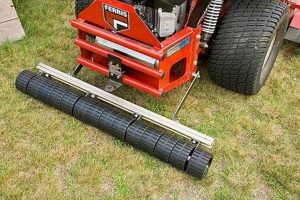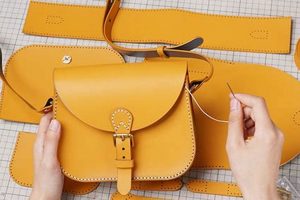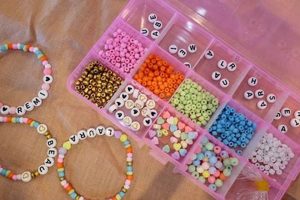A do-it-yourself guitar construction package designed specifically for left-handed individuals provides all the necessary components and instructions to assemble a fully functional electric guitar. These packages typically include a pre-cut guitar body, neck, hardware (such as tuning pegs, bridge, and pickups), electronics (pots, switches, and wiring), and detailed assembly guides. The defining characteristic is the mirror-image configuration of the instrument, accommodating the playing style of a left-handed guitarist.
The value of these kits lies in several areas. They offer a cost-effective alternative to purchasing a pre-assembled left-handed guitar, which often carries a higher price due to lower production volumes. The construction process provides a hands-on learning experience, deepening understanding of the instrument’s mechanics and electronics. Furthermore, the customizable nature of these kits allows for personalization of the guitar’s appearance and sound, leading to an instrument tailored to individual preferences. Historically, left-handed guitarists have faced limited instrument availability; these kits represent a growing market segment addressing this disparity.
The subsequent sections will delve into the selection criteria for appropriate kits, explore common challenges encountered during assembly, offer solutions to these challenges, and provide guidance on customizing the finished instrument to achieve desired aesthetic and sonic qualities. Detailed attention will be given to ensuring proper intonation and setup for optimal playability.
Assembly Strategies for Left-Handed Guitar Construction Kits
Successful assembly of a guitar construction package requires careful planning and execution. The following strategies are designed to optimize the building experience and ensure a high-quality finished instrument.
Tip 1: Comprehensive Inventory: Prior to commencing assembly, meticulously inventory all components against the provided parts list. Discrepancies should be addressed with the supplier immediately to avoid project delays.
Tip 2: Thorough Manual Review: Fully comprehend the assembly manual before initiating any physical work. Pay close attention to diagrams and instructions, clarifying any ambiguities through online resources or expert consultation.
Tip 3: Controlled Workspace: Establish a clean, well-lit, and organized workspace. Adequate space minimizes the risk of component damage and promotes efficient workflow.
Tip 4: Precision Soldering: Employ proper soldering techniques when connecting electronic components. Cold solder joints can lead to signal loss and instrument malfunction. Verify continuity with a multimeter.
Tip 5: Neck Alignment Verification: Prior to final neck attachment, confirm proper neck alignment with the guitar body. Misalignment will result in intonation problems and reduced playability. Use precise measuring tools for accurate placement.
Tip 6: Gradual Hardware Installation: Avoid over-tightening hardware during initial installation. Gradual tightening allows for adjustments and prevents damage to the wood.
Tip 7: Shielding Consideration: Implement shielding techniques, such as copper foil application in the control cavity, to minimize unwanted noise and interference. This is especially crucial for high-gain amplifiers.
Adhering to these guidelines increases the probability of a successful assembly, yielding a playable and aesthetically pleasing instrument. Patience and attention to detail are paramount throughout the entire process.
The subsequent section will address troubleshooting common issues encountered during the assembly phase, providing practical solutions for resolving potential setbacks.
1. Orientation
Orientation, in the context of a do-it-yourself guitar construction package, signifies the crucial adaptation of the instrument’s design and component placement to accommodate the specific needs of left-handed players. This fundamentally alters the guitar’s ergonomics and functionality.
- Mirror-Imaged Body Design
The body shape is mirrored to ensure comfortable access to the higher frets and proper arm positioning. The cutaway, for example, is typically positioned on the opposite side compared to a right-handed instrument, facilitating easier access to the upper register for the left hand. The location of the controls (volume, tone) must also be considered with their placement optimized for easy access with the right hand.
- Reversed Headstock and Nut
The headstock is often reversed, altering the string length and potentially influencing the instrument’s tone and feel. More critically, the nut the slotted piece at the headstock end that guides the strings must have string slots cut specifically for left-handed stringing. Using a right-handed nut on a left-handed guitar would result in improper string spacing and tuning instability.
- Reversed Bridge and Saddle Configuration
The bridge, which anchors the strings to the guitar body, and the saddles, which determine the string’s length and intonation, must be configured for left-handed playing. This ensures correct string spacing and accurate intonation across the fretboard. A standard right-handed bridge would result in improperly spaced strings and render accurate intonation impossible.
- Control Layout and Wiring
The control knobs and pickup selector switch are positioned to be easily accessible to the strumming hand. Furthermore, the wiring of the pickups and potentiometers must be reversed to maintain the intended tonal characteristics. Standard wiring can result in reversed control functionality or unintended tone alterations.
These considerations collectively define the “orientation” of a do-it-yourself guitar package, ensuring that the finished instrument is ergonomically and functionally suitable for a left-handed guitarist. Neglecting these orientation-specific adaptations would result in an instrument that is difficult, if not impossible, to play comfortably and accurately.
2. Component Quality
The quality of components within a left-handed DIY guitar kit directly determines the instrument’s playability, longevity, and overall sonic performance. Inferior components often lead to functional issues, decreased lifespan, and compromised sound quality. For instance, low-grade tuning machines struggle to maintain accurate pitch, necessitating frequent adjustments and hindering consistent playing. Similarly, subpar pickups yield a weak or muddy tone, failing to capture the instrument’s potential sonic character. The correlation is straightforward: higher-quality components translate directly into an enhanced playing experience and a more durable, reliable instrument. A budget-oriented kit employing zinc alloy for the brid
ge, as opposed to steel or brass, may exhibit premature wear and contribute to a dull sound. This demonstrates the tangible impact of material selection on the finished product.
Component quality influences various aspects of the guitar’s functionality. The neck’s wood quality affects its stability and resistance to warping, directly impacting intonation and action. Higher-grade woods, such as maple or mahogany, offer greater stability compared to cheaper alternatives like basswood or agathis. Similarly, the quality of the electronics potentiometers, capacitors, and wiring impacts the signal path and tonal clarity. Poorly shielded wiring or inexpensive potentiometers can introduce unwanted noise and limit the instrument’s dynamic range. The durability of the finish applied to the guitar body is also linked to component quality; a robust finish protects the wood from moisture and scratches, preserving the instrument’s appearance and structural integrity over time.
Therefore, the selection of a left-handed DIY guitar kit should prioritize component quality as a primary consideration. While budget constraints often influence purchasing decisions, investing in a kit with higher-grade components ultimately yields a more rewarding and long-lasting instrument. Understanding the specific impact of individual components on the guitar’s overall performance is crucial for making informed choices and achieving the desired results. A well-constructed kit with quality components provides an excellent platform for learning about guitar construction and creating a personalized instrument with professional-grade characteristics. The challenge lies in balancing cost with quality to achieve the optimal outcome.
3. Assembly Instructions
The assembly instructions provided with a left-handed DIY guitar kit serve as the critical link between raw components and a functional musical instrument. These instructions directly dictate the success or failure of the construction process. Improper or incomplete guidance can result in a non-playable instrument or even damage to valuable components. For instance, incorrect wiring diagrams within the instructions can lead to short circuits or non-functional pickups. Similarly, imprecise measurements or unclear explanations regarding neck alignment can cause intonation problems that render the finished guitar unusable. The instructions are not merely suggestions; they are a procedural roadmap that must be followed meticulously.
The complexity of the instructions reflects the complexity of the instrument itself. A well-designed set of assembly instructions includes detailed diagrams, step-by-step procedures, and clearly labeled components. These instructions often incorporate visual aids, such as photographs or illustrations, to clarify potentially ambiguous steps. Furthermore, high-quality instructions address common pitfalls and provide troubleshooting tips to assist builders in resolving unexpected issues. For example, some instructions include specific torque values for tightening screws to prevent over-tightening and damage to the wood. Others provide guidance on achieving proper string action and intonation, critical factors for playability. The absence of such detailed information can leave builders struggling to complete the project successfully.
In conclusion, the assembly instructions constitute an indispensable element of any left-handed DIY guitar kit. Their clarity, accuracy, and completeness directly correlate with the builder’s ability to successfully construct a playable and aesthetically pleasing instrument. Manufacturers who invest in well-designed and comprehensive instructions enhance the overall building experience and increase the likelihood of customer satisfaction. Conversely, inadequate or poorly written instructions can lead to frustration, wasted resources, and a disappointing outcome, undermining the entire purpose of the kit. The instructions, therefore, are not a mere addendum but a cornerstone of the DIY guitar kit experience.
4. Electronics Configuration
Electronics configuration represents a critical aspect of a left-handed DIY guitar kit, directly influencing the instrument’s tonal capabilities and overall performance. The arrangement and quality of electronic components dictate the guitar’s sonic characteristics and responsiveness. This configuration must be meticulously planned and executed to ensure optimal functionality and compatibility with a left-handed playing style.
- Pickup Selection and Placement
The type and positioning of pickups are paramount in shaping the guitar’s sound. Humbuckers offer a thicker, more powerful tone suitable for rock and metal, while single-coil pickups produce a brighter, clearer sound often favored for blues and country. In a left-handed configuration, the pickup placement must be reversed to maintain the intended tonal balance. For instance, the bridge pickup, typically responsible for brighter tones, should remain in the bridge position despite the mirrored layout. Incorrect pickup placement results in altered tonal characteristics and diminished performance.
- Potentiometer and Capacitor Values
Potentiometers (pots) control the volume and tone of the guitar, while capacitors shape the frequency response. The values of these components directly influence the sweep and range of the controls. Using inappropriate potentiometer values can result in a limited or abrupt volume taper. Similarly, incorrect capacitor values can lead to a muddy or overly bright tone. In a left-handed guitar, these components must be wired correctly to ensure that the volume and tone controls function as intended, not in reverse. Precise wiring is critical for maintaining the intended functionality.
- Switching Options and Wiring Schemes
Switches provide the ability to select different pickup combinations, offering a wider range of tonal possibilities. Common switching options include three-way, five-way, and push-pull configurations. The wiring scheme dictates which pickups are active in each switch position. In a left-handed guitar, the wiring of the switch must be carefully planned to ensure that the desired pickup combinations are selected correctly. Incorrect wiring can result in unexpected or non-functional pickup selections, limiting the instrument’s versatility.
- Shielding and Grounding Techniques
Shielding and grounding are essential for minimizing unwanted noise and interference. Shielding involves lining the control cavity with conductive material, such as copper foil, to block electromagnetic interference. Grounding provides a path for stray electrical signals to dissipate, reducing hum and buzz. In a left-handed guitar, proper shielding and grounding are particularly important due to the potential for reversed wiring and altered component placement. Effective shielding and grounding are crucial for achieving a clean and noise-free signal.
These facets of electronics configuration underscore its importance in a left-handed DIY guitar kit. Proper selection, placement, and wiring of electronic components are essential for achieving the desired tonal characteristics and ensuring optimal performance. Careful attention to these details results in a versatile and responsive instrument that meets the specific needs of a left-handed guitarist. The ultimate goal is a functional and satisfying musical experience.
5. Playability
Setup
Playability setup represents a critical final stage in the construction of a left-handed DIY guitar kit. This process involves adjusting various parameters of the assembled instrument to optimize comfort, ease of use, and intonation accuracy. The inherent nature of a DIY kit necessitates that the builder, rather than a factory technician, assumes responsibility for this crucial step. Neglecting proper setup procedures can result in an instrument that is difficult to play, prone to inaccurate intonation, and ultimately, unsatisfying to the user. For instance, if the action (string height) is set too high, the guitarist will experience excessive finger fatigue and difficulty fretting notes cleanly. Conversely, an action that is too low may lead to string buzzing and a loss of sustain. The interplay between these factors underscores the importance of meticulous attention to detail during the setup process.
The specific adjustments involved in a playability setup typically include: truss rod adjustment to control neck relief, string height adjustment at the bridge saddles, intonation adjustment to ensure accurate pitch across the fretboard, and pickup height adjustment to optimize tonal balance and output. The truss rod’s adjustment counters the string tension and ensures that the neck has a slight concave curve, which is essential for proper intonation and avoiding string buzz. Saddle adjustments at the bridge enable individual string height to be precisely dialed in, catering to personal preferences and playing style. Intonation correction is performed by altering the string length at the bridge saddles, ensuring that the pitch of each string remains accurate across the entire fretboard. Finally, adjusting the distance between the pickups and the strings affects the signal strength and tonal characteristics of the instrument. A properly executed setup transforms a collection of parts into a cohesive and responsive musical tool, catering specifically to the needs of a left-handed player.
In conclusion, playability setup is not merely a finishing touch but an integral component of the left-handed DIY guitar kit experience. It bridges the gap between assembly and performance, enabling the guitarist to realize the instrument’s full potential. The absence of a professional setup renders the time and effort invested in assembly less meaningful, ultimately diminishing the overall value of the kit. Therefore, dedicating sufficient time and attention to proper setup procedures is essential for achieving a satisfying and rewarding musical outcome. The end goal is a musical instrument that meets the players’ needs.
6. Customization Options
Customization options represent a significant benefit inherent in the nature of do-it-yourself guitar construction packages, particularly for left-handed instruments. Due to the historically limited availability and higher cost of factory-produced left-handed guitars, DIY kits provide a unique avenue for personalization that is often unattainable through conventional retail channels. These options extend beyond mere aesthetics, encompassing functional and ergonomic adjustments tailored to the individual player’s preferences and playing style. The ability to select specific hardware components, such as pickups, bridges, and tuning machines, allows for the fine-tuning of the instrument’s sonic character and overall performance. For instance, a left-handed guitarist seeking a specific vintage tone may opt for a kit that accommodates aftermarket pickups renowned for replicating that particular sound. The effect is a highly personalized instrument that aligns perfectly with the musician’s artistic vision.
Beyond component selection, the physical attributes of the guitar itself are often subject to customization within the DIY framework. The unfinished body and neck, typically included in these kits, provide a blank canvas for personalized finishes, ranging from custom paint jobs to intricate wood staining techniques. Furthermore, subtle modifications to the neck profile or body contours can be implemented to enhance playing comfort and ergonomics. A left-handed player with smaller hands, for example, might choose to thin the neck profile to improve grip and facilitate faster playing. Another common customization involves altering the control layout to better suit individual preferences, re-positioning volume and tone knobs for easier access during performance. These subtle yet significant modifications distinguish the DIY instrument from mass-produced alternatives.
In summary, customization options are a driving force behind the appeal of left-handed DIY guitar kits. They empower musicians to create instruments that are not only tailored to their physical needs but also reflective of their individual artistic expression. The capacity to select specific components, modify physical attributes, and implement personalized finishes elevates the DIY experience beyond mere assembly, transforming it into a creative endeavor that yields a truly unique and personalized musical instrument. The challenges in realizing these customizations often involve acquiring the necessary skills and tools, however, the end result justifies the effort expended.
Frequently Asked Questions
This section addresses common inquiries and misconceptions regarding the construction and utilization of guitar construction kits tailored for left-handed individuals. The information provided aims to clarify key aspects and provide guidance for potential builders.
Question 1: Are left-handed DIY guitar kits simply right-handed kits with reversed components?
No. While some components may appear similar, a true left-handed kit features a mirrored body, a reversed headstock, and properly oriented bridge components designed to accommodate left-handed stringing and playing. Attempting to convert a right-handed kit to left-handed configuration will result in improper intonation and ergonomic issues.
Question 2: What level of skill is required to assemble a left-handed DIY guitar kit?
The required skill level varies depending on the kit’s complexity. Some kits are designed for beginners with minimal soldering experience, while others require advanced knowledge of electronics and woodworking. Thoroughly review the kit’s documentation and assess personal skill level before purchase. Prior experience with soldering, basic woodworking, and electronics is highly recommended.
Question 3: Are specialized tools required for assembling a left-handed DIY guitar kit?
Yes. Essential tools include soldering iron, wire strippers, multimeter, screwdrivers (various sizes), adjustable wrench, ruler, and potentially, fret files and crowning tools for leveling and shaping the frets. Certain kits may require specialized clamps or jigs for neck attachment. Consult the kit’s documentation for a comprehensive tool list.
Question 4: What are the most common challenges encountered during assembly, and how can they be avoided?
Common challenges include incorrect wiring, improper neck alignment, and difficulty achieving proper intonation. These can be mitigated by meticulously following the assembly instructions, double-checking all connections, and utilizing accurate measuring tools. Consulting online forums and seeking expert advice can also prove beneficial.
Question 5: Does the quality of the components sign
ificantly impact the final product?
Component quality directly affects the instrument’s playability, longevity, and sonic characteristics. Inferior components, such as low-quality pickups or tuning machines, can compromise the guitar’s sound and functionality. Investing in a kit with higher-grade components is recommended for a superior playing experience.
Question 6: How can the finished guitar be customized to suit individual preferences?
Customization options include selecting aftermarket pickups, modifying the finish, and adjusting the neck profile. After assembly, professional setup by a qualified guitar technician is recommended to optimize playability and intonation. Careful consideration of these options allows for the creation of a personalized instrument.
In conclusion, left-handed DIY guitar kits provide a cost-effective and customizable alternative to purchasing pre-built instruments. However, successful assembly requires a dedicated approach, a certain level of skill, and a commitment to detail. Thorough research and careful planning are essential for achieving a satisfactory outcome.
The following section will explore the benefits of completing one.
Conclusion
The preceding discussion has illuminated the multifaceted nature of left handed diy guitar kit. It has detailed its construction, assembly strategies, essential aspects, and customization options. The benefits extend from cost savings and educational experience to personalized instrumentation. The information presented serves as a comprehensive resource for individuals considering this endeavor.
The act of constructing a musical instrument tailored to individual specifications remains a compelling proposition. This endeavor demands meticulous planning, dedicated effort, and informed decision-making. Those who approach the left handed diy guitar kit with diligence and precision can expect to gain a deep understanding of guitar construction and, ultimately, create a unique instrument that resonates with their specific needs and artistic vision. Successful construction will lead to a rewarding, functional instrument.







